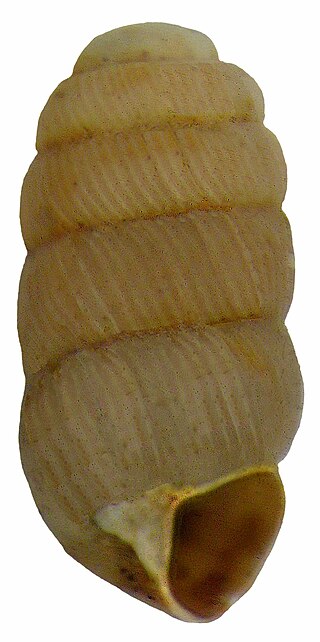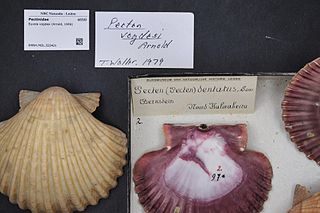
A tunicate is an exclusively marine invertebrate animal, a member of the subphylum Tunicata. This grouping is part of the Chordata, a phylum which includes all animals with dorsal nerve cords and notochords. The subphylum was at one time called Urochordata, and the term urochordates is still sometimes used for these animals. They are the only chordates that have lost their myomeric segmentation, with the possible exception of the seriation of the gill slits. However, doliolids still display segmentation of the muscle bands.

Pyroteuthidae is a family of squids. The family comprises two genera. Species are diurnally mesopelagic, migrating into surface waters during the night. The family is characterised by the tentacles, which have a permanent constriction and bend near the base; and photophores occurring on the tentacles, eyeballs, and viscera. Members reach mantle lengths of 23–50 mm. Paralarvae of the family are common around the Hawaiian Islands, with up to 17% of collected specimens in the area belonging to Pyroteuthidae.

Onykia carriboea, the tropical clubhook squid, is a squid in the family Onychoteuthidae, the type species of the genus Onykia. It is known with certainty only from immature specimens. The type locality of O. carriboea is the Gulf of Mexico. Onykia robsoni has been suggested as a junior synonym, owing to similarities between the species.

Xipholeptos is a genus of squid in the family Idiosepiidae. It is monotypic, being represented by the single species Xipholeptos notoides, commonly known as the southern pygmy squid. The species was originally classified as Idiosepius notoides. The southern pygmy squid is native to the southwestern Pacific Ocean, off southern and eastern Australia. It inhabits shallow, inshore waters. It has been recorded off the coasts of New South Wales, South Australia, Tasmania and Victoria.
Moroteuthopsis longimana, also known as the giant warty squid or longarm octopus squid, is a large species of hooked squid. It attains a mantle length of at least 85 cm and probably over 1.15 m. The largest complete specimen of this species, measuring 2.3 m in total length, was found in Antarctica in 2000.

Magnoteuthis microlucens is a species of squid; the most common species of Mastigoteuthis around the main Hawaiian Islands.
Exquisitiropa is a monotypic genus of small land snails in the family Charopidae. The sole species is Exquisitiropa agnewi, also known as silky snail or silky pinwheel snail. It is endemic to Tasmania.

Onychoteuthis compacta is a species of squid in the family Onychoteuthidae, known to occur in Hawaiian waters. as well as in other areas of the Central Pacific and western north-central Atlantic, it probably has a circumglobar distribution. The species is known to have a mantle length of at least 122 mm for females and 127 mm for males. Each tentacle has 22 club hooks, measuring approximately 30 mm in mature specimens.
Notonykia nesisi is a species of squid in the family Onychoteuthidae. It is differentiated from Notonykia africanae by the shape of the tentacles. While the species is only known from immature specimens, it is known to achieve a mantle length of at least 100 mm. The tentacles are about 65-115% of the mantle length, and contain 6-18 hooks.

Guildfordia yoka, the yoka star turban, is a species of deep-water sea snail, a marine gastropod mollusk in the family Turbinidae, the turban snails.

Sigmurethra is a taxonomic category of air-breathing land snails and slugs, terrestrial pulmonate gastropod molluscs. This is an informal group which includes most land snails and slugs.

Basilissopsis is a genus of sea snails in the family Seguenziidae.
The Antarctic neosquid is the only neosquid in the genus Alluroteuthis. The tentacles are relatively short compared to the arms.
Walvisteuthis virilis is a species of squid from the family Onychoteuthidae, it is the type species of the genus Walvisteuthis. It may be synonymous with Walvisteuthis rancureli. The type specimen was collected, as a mature male with a mantle length of 71 mm, near the Walvis Ridge in the eastern South Atlantic Ocean at a depth of 1000m. A second specimen was subsequently collected on the other side of the South Atlantic, also a mature male with a total length of 71mm.

After excluding groups not related, the informal group Sigmurethra has become the suborder Helicina, with the following infraorders and a collection of families with no superfamily:
Onychoteuthis bergii is a species of hooked squid from the family Onychoteuthidae. The species was originally described by Hinrich Lichtenstein from specimens taken near the Cape of Good Hope and is the type species of the genus Onychoteuthis. Until recently it was considered to be a junior synonym of Onychoteuthis banksii, but a re-examination of the type material, the lectotype and paralectotype which are deposited in the Natural History Museum, Berlin, showed that there were morphological differences which supported the status of O. bergii as a valid species. The species is found in the eastern South Atlantic and Indian Oceans.
Rokopella oligotropha is a species of monoplacophoran, a superficially limpet-like marine mollusc. It is known from only one specimen and a shell fragment collected in the north-central Pacific Ocean.
Monoplacophorus zenkevitchi is a species of monoplacophoran, a superficially limpet-like marine mollusc. It is known from only one specimen collected from a depth of 2000 metres in the Pacific Ocean, north of Johnston Island and west of Hawaii.
Adenopilina adenensis is a species of monoplacophoran, a superficially limpet-like marine mollusc. It is known from only one specimen collected from a depth of 3000–4000 metres in the Alula-Fartak Trench of the Gulf of Aden, off the coast of Yemen.

Euvola vogdesi is a species of bivalve belonging to the family Pectinidae. The species is found on the Pacific Coast of North and Central America. Fossil specimens are known from Mexico and California.










